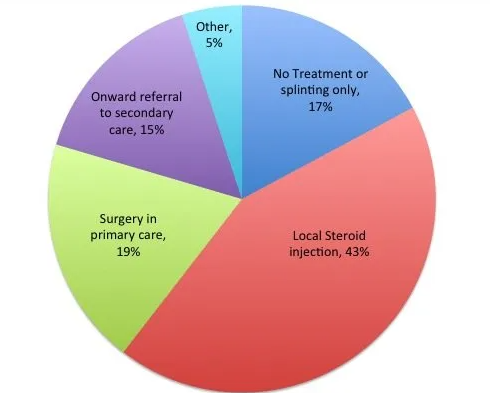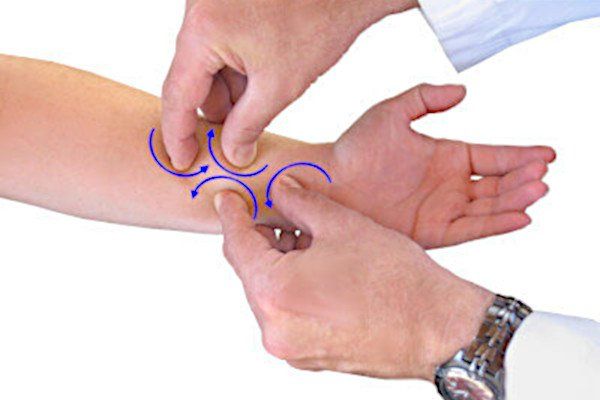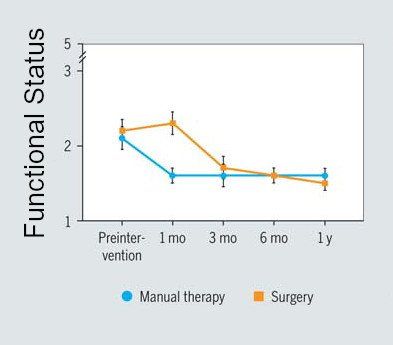Treating Carpal Tunnel Syndrome: Surgery vs. Physical Therapy
Physical therapists and chiropractors have long known that physical therapy for carpal tunnel is typically more effective than carpal tunnel surgery. That's why it's routinely used to treat this painful and numbing condition of the hand.
For decades, there have been innumerable anecdotal reports and scientific investigations about the effects of
various forms of physical therapy on carpal tunnel syndrome. They conclude that physical therapy can effectively and permanently relieve
signs and symptoms of carpal tunnel syndrome (CTS).
Collectively, they provide decisive evidence that physical therapy is more effective than surgery. Accordingly, the
American Academy of Orthopedic Surgeons (AAOS) recommends physical therapy as the first CTS treatment modality and cautions that surgery should be used only as a last resort. Additionally, a physical therapy patient's emotional and financial costs are small compared to those of a surgery patient.
In all, the benefits of physical therapy outweigh those of surgery. However, most patients are unaware of this fact.
Below, you’ll find:
- A summary of the impact on the medical community for treating carpal tunnel with physical therapy (PT) and a probable explanation as to WHY no one seems to know it's more effective than surgery.
- A summary of the research describing why the AAOS recommends surgeons send their patients to physical therapists BEFORE resorting to surgery.
- A summary of the effectiveness of carpal tunnel therapy massage and how to perform it.
Physical Therapy for carpal tunnel syndrome bucks the surgical establishment.
For physical therapists and chiropractors, the financial impact of PT to treat carpal tunnel could be very good for business, given the vast numbers of people suffering from CTS. That is, if people were given a choice between surgery or PT.
However, the opposite is true for hand surgeons – carpal tunnel surgery is the
second most common operation they perform, and the potential loss of their income could be staggering if even only a fraction of these patients selected PT over surgery.
This is a possible explanation why most hand surgeons ignore the AAOS guidelines to recommend physical therapy as the FIRST treatment for CTS:
what’s best for the patient is not best for the surgeon’s pocketbook.
The fact is, few hand surgeons inform patients physical therapy is an option. It’s also possible many aren’t aware of its efficacy. Most primary care physicians are seemingly unaware because they immediately refer CTS sufferers to a surgeon rather than to a physical therapist. But is ignorance an excuse? Shouldn’t the oath to “first do no harm” demand our doctors keep up-to-date and prioritize people over profits?
Getting the word out about the advantage of PT over surgery bucks the surgical establishment’s reign over medical information and is akin to an ant trying to move a mountain. The proof is the fact that carpal tunnel release surgeries are on the rise, in spite of the operation’s
relatively poor success rate.
So it’s doubtful this single article will change minds. But it’s at least a forward step to begin the distribution of this information. Please share it with your friends and family. If we get enough ants working together,
we can move mountains!
Carpal tunnel surgery is big business.
Arthritis is the most frequent hand problem doctors diagnose and treat. The second most frequent problem is carpal tunnel syndrome. It afflicts 5 million Americans (1.5%). That translates into over
230,000 hand operations performed annually. As one of the
most common hand operations performed in America, carpal tunnel surgery accounts for up to
$5 billion annually in the Medicare population alone.
Bear in mind this is the
diagnosed number. Undiagnosed cases go unreported and uncounted.
The low estimate is that
undiagnosed severe carpal tunnel has an incidence of
0.7% (that’s over 2 million Americans). Therefore, millions of Americans are going about their lives with undiagnosed,
severe-stage carpal tunnel syndrome.
And that’s not even considering
mild- or moderate-stage cases. The high estimate for that incidence is
5% (representing over 15 million Americans).
Clearly, we have an underappreciated problem going on, and the surgical establishment capitalizes on consumer ignorance of treatment options.
Upon the first visit to a doctor or specialist today, a patient with carpal tunnel syndrome has a 33% chance of being referred for hand surgery
immediately.
This is in spite of the recommendations of the
American Academy of Orthopedic Surgeons. They advise all doctors to recommend surgery
only if
ALL of the following 3 criteria are met:
- Severe symptoms present for at least 6 months.
This is important in light of the fact that 60% of patients see their
carpal tunnel symptoms resolve on their own. That means numbness, pain, tingling, or weakness will simply disappear with no (or very little) help. Usually, this occurs within a month of the symptoms first being noticed. But in the other 40% of patients, the situation is different. If symptoms last for more than a few months without therapy, they’ll usually remain. And in most of those sufferers, symptoms will get even more intense over time.
- Symptoms are so severe they interfere with daily life.
Within 6-12 months after
carpal tunnel symptoms first appear, they generally advance to the
severe stage. This is when patients report the greatest impact on their lives. For instance, it’s almost impossible to get a restful night’s sleep. Using their hands on the job or doing simple tasks at home is difficult. They fumble, drop things, and simply cannot sustain any hand or finger activity for more than a few minutes.
- All nonsurgical remedies were tried without success. Nonsurgical remedies usually treat carpal tunnel syndrome quite effectively. The main therapies are
night bracing,
stretching exercises, and
myofascial release massage. The vast majority of patients normally see complete relief using one or more of these therapies.
The criteria for having carpal tunnel surgery should be enforced.
Under ideal circumstances,
your carpal tunnel doctor will determine whether you meet each of the above criteria. Then the doctor will usually recommend carpal tunnel release surgery.
However, 19% of doctors disregard this process and recommend surgery immediately. (See
infographic below).
What is the effectiveness of physical therapy vs. surgery for carpal tunnel?
Comparisons have been made between patients receiving
endoscopic carpal tunnel release surgery versus manual physical therapy for carpal tunnel.
A group of massage therapy patients received 3, 30-minute treatment sessions (once per week for three weeks). The interventions consisted of maneuvers focusing on the cervical spine and the areas anatomically related to median nerve entrapment (at the shoulder, elbow, forearm, wrist, and fingers).
Beyond the three sessions in the first three weeks, only self-stretching was performed on a continued basis, as needed by the patient.
Here’s what we found out about PT vs. CTS surgery, as we’ve mentioned above:
- Both have an equivalent effect on reducing symptoms
- Both have an equivalent improvement in hand function.
We’ll explain both a little more below, but keep this in mind:
all else being equal, why would you ever make surgery your first resort rather than a non-invasive massage routine?
Equivalent effect on reducing symptoms.
Equivalent improvement in hand function.
Clinical proof: carpal tunnel therapy massage
works.
As we stated at the beginning of this article, massage has been used for decades by therapists to eliminate symptoms. Actually,
several clinical trials have proven the effectiveness of massage for carpal tunnel syndrome.
For example, people who use a
computer keyboard are helped tremendously by massage. And symptoms can be eliminated in six weeks. In particular, their
chronic hand pain is gone, and they regain
grip strength. Most impressive of all, their
EMG (electromyographic) results
improve dramatically. This demonstrates that their
median nerve (damaged by carpal tunnel syndrome) has been
restored.
Finally, as we have emphasized above,
studies compared massage to
carpal tunnel surgery. They show that massage is at least as effective as surgery, with over
80-90% effectiveness against
symptoms.
In short, there's extensive clinical evidence to show carpal tunnel therapy massage is effective in eliminating symptoms and restoring your hand. The effectiveness and how long restoration takes place depends on how long you've had symptoms and how severe they are.
However, not just ANY massage is effective. By far, the most powerful type of massage therapy is called
myofascial release.
Details of myofascial release massage.
Myofascial release massage is a powerful carpal tunnel fighter because of HOW it's performed. To understand this, it's important to know some basics of carpal tunnel syndrome.
- Carpal tunnel symptoms (pain, numbness, tingling, burning, weakness, etc.) happen because the median nerve in your wrist is
compressed.
- Nerve compression occurs because your wrist's
flexor tendons around the nerve are
inflamed and swollen.
- The flexor tendons are swollen due to irritation caused by
fibrous adhesions and restrictions between them.
- These adhesions are a result of (usually)
overworking your fingers rapidly and repetitively (like typing).
Therefore, if you eliminate the adhesions, everything else falls into place. The result is the median nerve is no longer compressed, and symptoms disappear.
This adhesion removal is exactly what myofascial release massage achieves. This very specific form of carpal tunnel therapy massage breaks up tendon adhesions in order to relieve tendon swelling and the resulting symptoms.
So how do therapists perform the massage?
How to perform the massage.
It takes some practice to perform this technique because it requires
two coordinated hands to achieve the proper effect. The practitioner puts the thumb and forefinger of each hand on the patient's wrist area. Then the practitioner makes gentle but firm short circular kneading motions.
The effect is like “kneading” dough. When properly performed, the practitioner can feel the flexor tendons below the skin strumming like a guitar. This is performed for about 15 minutes.
About the massage regimen.
Myofascial release massage is highly effective against carpal tunnel syndrome. But it must be performed often. A therapist must do it for fifteen minutes every day for at least four weeks.
Some patients have severe carpal tunnel symptoms. In those instances, massage therapy may require four to six weeks of daily (or twice daily) application to obtain good results.
Note:
CarpalRx is an
automated myofascial release massager. This medical device provides the identical carpal tunnel therapy massage you get from a therapist for your wrist and forearm.
Conclusion
Over decades of patient interactions and multiple clinical studies, manual physical therapy for carpal tunnel can be compared side-by-side to surgery. The results show that patients having surgery fare as well, but at times slightly worse, than patients who undergo targeted manual physical therapy treatment. The conclusion is that physical therapy is at least as good as surgery for treating carpal tunnel syndrome. Combined with the lower cost, lack of trauma, and zero complications, manual physical therapy for carpal tunnel should be the first treatment modality ordered by doctors. Specifically, patients should undergo myofascial release, which is highly effective at relieving symptoms within four to six weeks. The speed of hand and finger restoration depends on how long the patient has had symptoms and how severe they are.
Sources
- Fernández-de-las Peñas C, Ortega-Santiago R, de la Llave-Rincón AI, et al. Manual physical therapy versus surgery for carpal tunnel syndrome: a randomized parallel-group trial. J Pain. 2015; 16: 1087–1094.
- César Fernández-de-las-Peñas, et.al. The Effectiveness of Manual Therapy Versus Surgery on Self-reported Function, Cervical Range of Motion, and Pinch Grip Force in Carpal Tunnel Syndrome: A Randomized Clinical Trial. J Orthopaedic & Sports Phys Ther; 2017, (47) 3.
- Jarvik, JG; Comstock, BA; Kliot, M; et al. Surgery versus non-surgical therapy for carpal tunnel syndrome: a randomised parallel-group trial. Lancet. 2009; 374: 1074–1081.
https://doi.org/10.1016/S0140-6736(09)61517-8.
- D. Rauf. Physical Therapy Equals Surgery for Carpal Tunnel.
https://www.webmd.com/pain-management/carpal-tunnel/news/20170324/physical-therapy-as-good-as-surgery-for-carpal-tunnel-syndrome-study.
- Benjamin M. Sucher. Myofascial release of carpal tunnel syndrome. J Am Osteopath Assoc. 1993 Jan; 93 (1): 92-4, 100-1.







